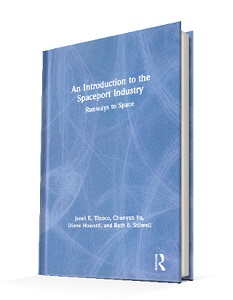The word ‘spaceport’ has been around for quite a while now, but the concept of a ‘spaceport industry’ is a more recent innovation, or should we say ‘aspiration’. After all, the word industry implies “a branch of commercial enterprise” engaged in “organised economic activity” (according to my Collins Concise!).
In an introductory chapter on definitions, history and policy, this book recognises that “definitions of spaceports are in flux”, largely because the technological solutions for getting to orbit are changing. As referenced by the book’s subtitle “Runways to Space”, many budding spaceports are sited where long runways already exist, on the assumption that future commercial spaceflight will be based on vehicles capable of horizontal take-off and landing. However, many other planned spaceports are based on the vertical launch of (mostly) small launch vehicles. Meanwhile, the technology of reusable first stages that return autonomously to the launch site, or an off-site recovery platform, has been ably demonstrated many times by SpaceX.
In eight chapters, this book aims to cover the subject of spaceports from multiple angles, including technical (vehicles and propulsion); infrastructure and operations; economic and financial; and licensing and planning. Each chapter has a reference list and there is a substantial index. The book as a whole is quite well illustrated with monochrome photos of spaceport infrastructure as it exists today, but there are surprisingly few ‘artist’s impressions’ of planned vehicles and spaceports.
The stance taken throughout much of the book is ‘educational’ rather than ‘academical’: it’s very much a description of what spaceports are, what they include, how they are funded and operated, and why they are becoming so widespread. It is, effectively, a spaceport primer and I would go so far as to suggest that anyone thinking of developing a spaceport should read this book first.











